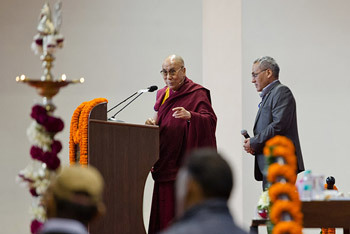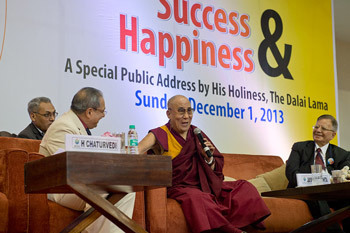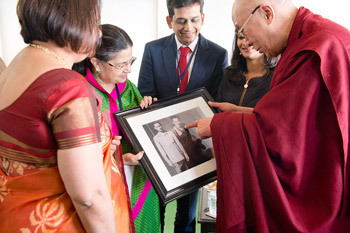New Delhi, India, 1 December 2013 - The Birla Institute of Management Technology (BIMTECH) invited His Holiness the Dalai Lama to address a select gathering of corporate leaders, civil servants, academicians, professionals, and diplomats today as part of its 25th anniversary celebrations. The event took place at the Jaypee Integrated Sports Complex, Greater Noida. His Holiness’s relations with the Birla family go back to the early days of his life in India. It was in their house in Mussoorie that he spent his first year in exile before moving to Dharamsala. In a brief meeting before his talk, he was presented with a framed photograph of himself with Mr & Mrs BK Birla on the veranda of Birla House in 1959 or 1960.
As part of the formal welcome, His Holiness was presented with a bouquet of flowers and in tribute to Mahatma Gandhi, who both he and the Birlas consider their mentor, a garland of khadi yarn. He then took part in lighting the lamp. There were words of welcome from Dr H Chaturvedi, BIMTECH director, as well as from Jayashree Mohta and Rajashree Birla, on behalf of the Birla family.
“It’s a great honour for me to have this opportunity to share my views and experiences with brothers and sisters like you,” His Holiness began. “I consider myself to be just another human being with not much difference between us. I remember it was perhaps 20th April 1959 that I reached Birla House in Mussoorie after several days journey by train. Soon afterwards, Pandit Nehru came to see me. I met him for the first time in Peking in 1954, then again at the time of the Buddha Jayanti celebrations in 1956. By then there was already trouble in Tibet and I told him I was thinking of not going back. He advised me that it would be better to go back and to try to manage the situation on the basis of the 17 point agreement.
“It’s been nearly 55 years since I came to stay at Birla House. I lost my home and found a new one in India, a country I’d always felt close to because of my studies. The Government of India took care of us. I am a refugee, but I’m also the longest staying guest of the Indian government. As a result of India’s help and the freedom I’ve enjoyed here, I’ve learned many things among them the ancient Indian concept of ahimsa or non-violence.”
He went on to explain that non-violence is not necessarily indicated by the quality of the action, but according to the motivation for it. He said that if we want to cheat and take advantage of someone and we smile, use sweet words and even proffer a gift, that’s a form of violence because of our negative motivation. On the other hand if, out of sincere concern for others’ well-being, we use harsh words, because our motivation is positive, this counts as non-violence. Corruption is widespread and is quite serious here in India; along with cheating and deception, it counts as a form of violence.

|
His Holiness the Dalai Lama speaking on "Success & Happiness" as part of Birla Insitute of Management Technology's 25th anniversary celebrations in Noida, India on December 1, 2013. Photo/Tenzin Choejor/OHHDL
|
Peaceful, non-violent action is related to warm-heartedness, which is something we need to promote on the basis of secularism. Because India is a multi-religious society, the freedom fighters decided there should be a secular constitution. It wouldn’t work to impose one religion or another, whereas secularism, from the Indian point of view, is respectful of all religions and even of the right to be agnostic. This is exemplified by the response to the ancient Charvaka or Hedonist school of thought, which challenged the spiritual approach. Nevertheless, even their teachers were referred to as rishis or sages.
“I’ve read that of the 7 billion human beings alive today, at least 1 billion claim to be non-believers. But of the remaining 6 billion who apparently have some faith, many are fairly superficial about it. Unless you are serious and sincere about religious practice, there is a grave risk of hypocrisy. Indeed, religion can clearly be used to exploit and manipulate people, when there is a lack of moral principles. Since my first visit to Europe in 1973 I realised we need to develop a sense of global responsibility, which treats the whole of humanity as part of our concern.
“Nobody wants problems, but we create them. They spring directly from our self-centred attitude. The opposite of this, compassion and concern for others is the key factor in the creation of a more peaceful world. If we base our compassion on religious faith, there’ll be limits to it. If, instead, we take a secular approach, there are no limits to what we might achieve.”
He said we need to reflect on our common experience: our birth from our mothers and the affection with which she cared for us, give us the ability to be affectionate to others
“From my own experience I can tell you that peace of mind is effective when it comes to our physical health. Scientists are verifying this with experiments to measure the benefits of meditating on compassion, from a secular point of view, over a period of three weeks or so. They found lower blood pressure, less stress and improved interaction with others. So, success and happiness are directly related to developing a calm mind rooted in compassion. If we pay attention to inner values, life can be happy. There will be problems, but the crucial issue is how we approach them.”

|
His Holiness the Dalai Lama answering questions from the audience during his talk on "Success & Happiness" in Noida, India on December 1, 2013. Photo/Tenzin Choejor/OHHDL
|
Inviting questions from the audience, His Holiness answered the first about suffering in relation to god or causality by pointing out that problems and suffering have their source in ignorance. Therefore, the solution lies in education. Asked to say which is more important, wisdom or moral principles, His Holiness remarked that because wisdom says be honest and truthful, wisdom is more important. To the question, which came first, success or happiness, he replied: “I don’t know, other than to suggest that happiness is related to having a calm mind. And a calm mind provides the basis for distinguishing right from wrong.”
Finally, His Holiness was asked about the strength of the movement for a free Tibet. He remarked that it was a political question and that he had retired from political concerns. Nevertheless, he recalled passing through the Chinese city of Xian on the way to and from Peking in 1954/5. Sitting on the ancient city wall, the guide pointed out that this was where the Tibetan army had reached in the 8th century BCE, when the Chinese Emperor had to flee.
His Holiness made clear that in 7th and 8th centuries there were three strong empires, the Tibetan, Mongolian and Chinese, but from the 9th century onwards Tibet disintegrated into petty kingdoms. Although these distinct empires were the case in the past, he said today requires a different solution. Because Tibet is materially backward, despite being culturally and spiritually rich, it is in Tibetans interest to remain with the People’s Republic of China.
He said, that just as the Palestinian problem can only be resolved through dialogue, the Tibetan issue also needs a mutually acceptable and beneficial solution.

|
Members of the audience listening to His Holiness the Dalai Lama speaking on "Success & Happiness" in Noida, India on December 1, 2013. Photo/Tenzin Choejor/OHHDL
|
“We have to live together, that’s why we seek mutual benefit through the Middle Way Approach (MWA). So far there has been no concrete response from the Chinese government, but among Chinese intellectuals, writers and activists there is great sympathy and solidarity for Tibet.
Meanwhile, Chinese hardliners continue to accuse us of being splittists. They know we are not, but they keep up the propaganda. It seems these hardliners need the idea of splittists to give them the excuse to keep up their crack down. The whole world knows we are not against the Chinese people. The governments of India, USA, and Europe support our MWA; this is a sign that it is realistic.”
As a token of gratitude at the end of his talk, BIMTECH offered His Holiness a large painting illustrating the life of the Buddha and requested him to bless a bodhi tree that will be planted in the BIMTECH campus. Following the vote of thanks, he returned to Delhi.
















